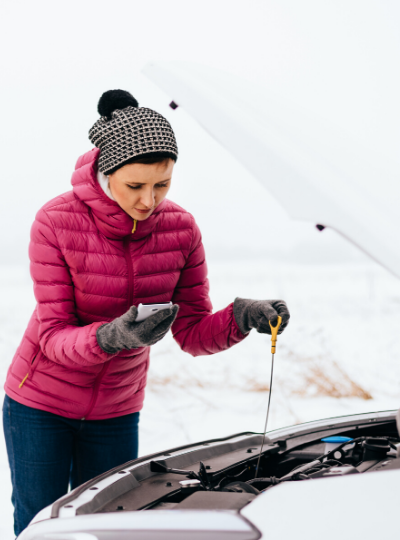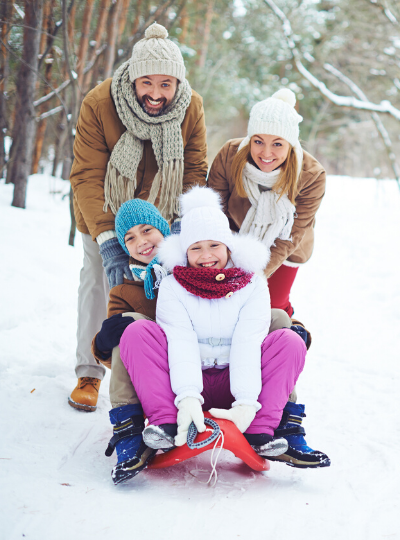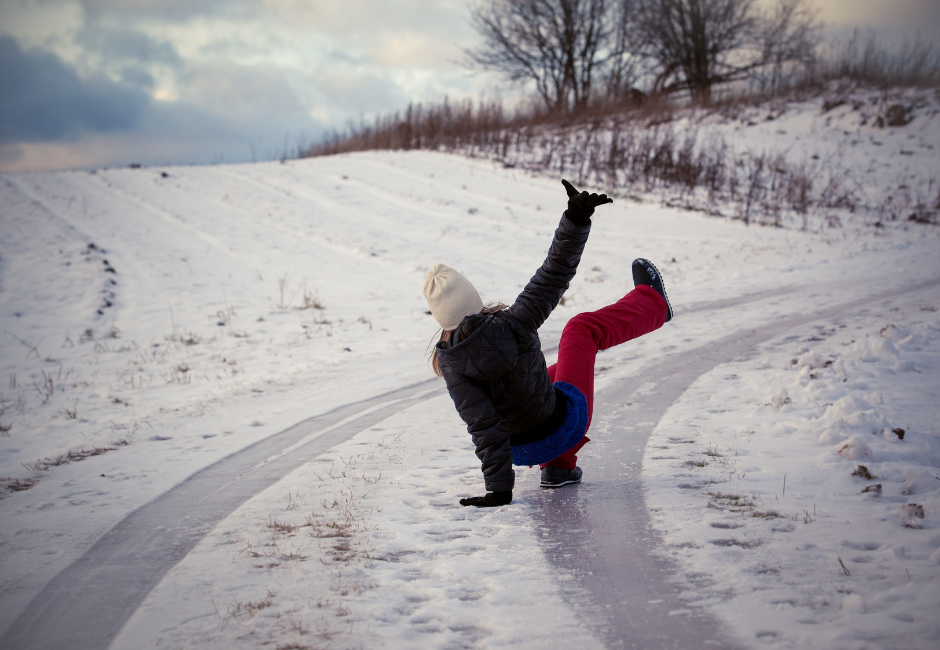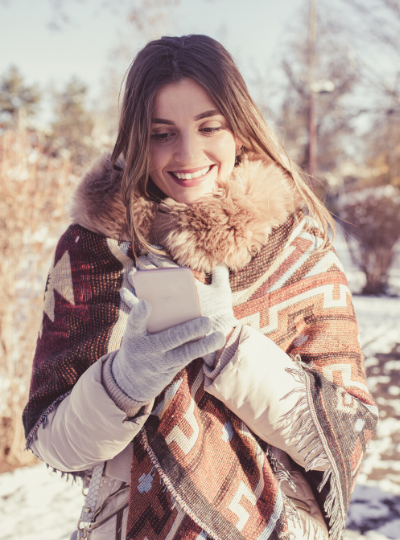8 Winter Safety Tips
Stay Healthy and Safe This Winter
Be Prepared
1. Drive Safely
AAA offers the following driving tips:
- Avoid using cruise control in wintry conditions
- Steer in the direction of a skid, so when your wheels regain traction, you don’t have to overcorrect to stay in your lane
- Accelerate and decelerate slowly
- Increase following distance to 8 to 10 seconds
- If possible, don’t stop when going uphill
If visibility is severely limited due to a whiteout, pull off the road to a safe place and do not drive until conditions improve. Avoid pulling off onto the shoulder unless it is an absolute emergency. Limited visibility means other vehicles can’t see yours on the shoulder.


BE PREPARED
2. Prepare Your Car
Is your car ready for winter travel? It’s not too late to winterize your car. Check out these car care tips to prepare you for winter driving:
- Check your tires and replace with all-weather or snow tires, if necessary.
- Keep your gas tank full to prevent ice from getting in the tank and fuel lines.
- Use a wintertime fluid in your windshield washer.
- Make an emergency kit to keep in your car. Include water, snacks, first-aid kit, blankets, flashlight, extra batteries, portable cell phone charger, and emergency flares.
BE PREPARED
2. Prepare Your Car
Is your car ready for winter travel? It’s not too late to winterize your car. Check out these car care tips to prepare you for winter driving:
- Check your tires and replace with all-weather or snow tires, if necessary.
- Keep your gas tank full to prevent ice from getting in the tank and fuel lines.
- Use a wintertime fluid in your windshield washer.
- Make an emergency kit to keep in your car. Include water, snacks, first-aid kit, blankets, flashlight, extra batteries, portable cell phone charger, and emergency flares.

BE PREPARED
3. Prepare Your Home
Winterize your home to help protect yourself and your family from any potential damage the cold temperatures and snow may bring.
Follow these tips to keep your home safe and warm:
- Check your heating systems.
- Clean out chimneys and fireplaces.
- Closely monitor any burning fires or candles.
- Check your carbon monoxide and smoke detectors.
- Remove ice and snow from walkways to prevent slips and falls.
- Keep an emergency kit in your home that includes flashlights, extra batteries, a first-aid kit, extra medicine, and baby items.
- If you lose power, your kit should also include food and water for three days for each family member, warm clothing if you have to evacuate, and toys and games for children.

BE PREPARED
4. Prepare For Outdoor Activities
Remaining indoors during the winter is appealing. But you and your family may want to venture outdoors to enjoy winter activities. When you do, take these steps to prevent serious injuries and illnesses, like hypothermia and frostbite:
- Wear layers of light and warm clothing, a wind-resistant coat, waterproof shoes, and a hat, gloves, and scarf.
- Work slowly when engaged in outdoor tasks, such as shoveling your driveway or removing snow from your car.
- Take a friend and carry a charged cell phone when participating in outdoor activities.
BE PREPARED
4. Prepare For Outdoor Activities
Remaining indoors during the winter is appealing. But you and your family may want to venture outdoors to enjoy winter activities. When you do, take these steps to prevent serious injuries and illnesses, like hypothermia and frostbite:
- Wear layers of light and warm clothing, a wind-resistant coat, waterproof shoes, and a hat, gloves, and scarf.
- Work slowly when engaged in outdoor tasks, such as shoveling your driveway or removing snow from your car.
- Take a friend and carry a charged cell phone when participating in outdoor activities.

BE SAFE
5. Avoid Snow Shoveling and Snowblowing Injuries
Shoveling snow or using a snowblower are among winter’s most grueling activities. High levels of activity in cold temperatures put many people at risk of heart attack, especially those that have inactive lifestyles.
While most people won’t have a problem, shoveling snow can put some people at risk of heart attack. Sudden exertion, like moving hundreds of pounds of snow after being sedentary for several months, can put a big strain on the heart. Pushing a heavy snow blower also can cause injury.
And, there’s the cold factor. Cold weather can increase heart rate and blood pressure. It can make blood clot more easily and constrict arteries, which decreases blood supply. This is true even in healthy people. Individuals over the age of 40 or who are relatively inactive should be particularly careful.
National Safety Council recommends the following tips to shovel safely:
- Do not shovel after eating or while smoking
- Take it slow and stretch out before you begin
- Shovel only fresh, powdery snow; it’s lighter
- Push the snow rather than lifting it
- If you do lift it, use a small shovel or only partially fill the shovel
- Lift with your legs, not your back
- Do not work to the point of exhaustion
- Know the signs of a heart attack, and stop immediately and call 911 if you’re experiencing any of them; every minute counts
Don’t pick up that shovel without a doctor’s permission if you have a history of heart disease. A clear driveway is not worth your life.

Be SAFE
6. Prevent Carbon Monoxide Poisoning

BE SAFE
7. Prevent Falls This Winter
When the rain and snow starts to fall, so do people. In fact, falls are the leading cause of nonfatal injuries in adults 45 and older. Protect yourself from a life-changing injury this winter with these safety tips:
1. Choose the right shoe. Shoes and boots need to fit properly and have soles with good traction. Snow boots or hiking boots will provide the best protection for the worst type of weather.
2. Leave early. Falls are more likely to happen when you’re in a rush. Allow yourself plenty of time to get to where you’re going.
3. Walk like a penguin. Take short steps and walk as flat-footed as possible on icy or slippery ground.
4. Keep your hands free. You’ll need them to help you balance, so avoid carrying heavy loads and keep those hands out of your pockets.
5. Remove snow and ice from walkways frequently. Don’t wait for it to melt. That could take awhile. Apply ice melt and ask for help if you need it.
6. Keep the lights on. If you have exterior lights on your home, use them to help see where you’re walking at night.
7. Advocate for your safety. If the entrances or sidewalks do not look safe outside of a business or a local venue, speak up and let someone know.

Be SAFE
8. Keep a Charged Phone With You
Your cell phone can help with any emergency you may come across walking, driving, or playing in the snow. It’s important to keep a charged cell phone with you or anyone you are out with, so you can call for help if anything were to happen!


